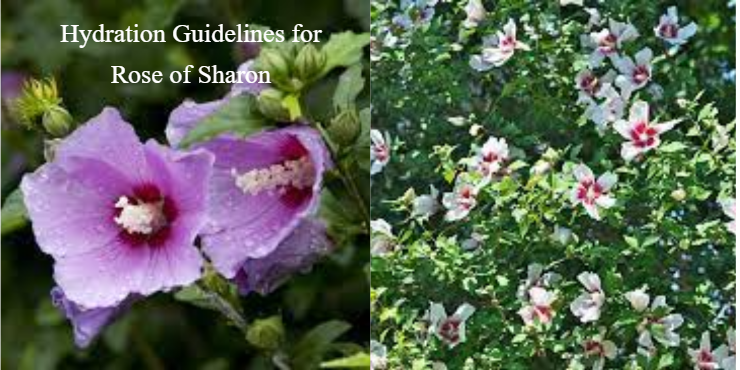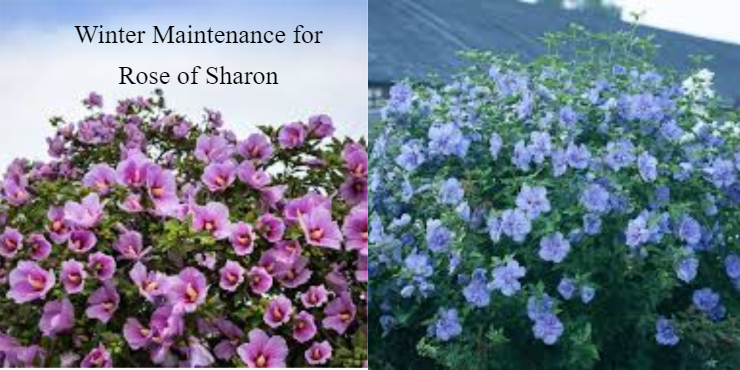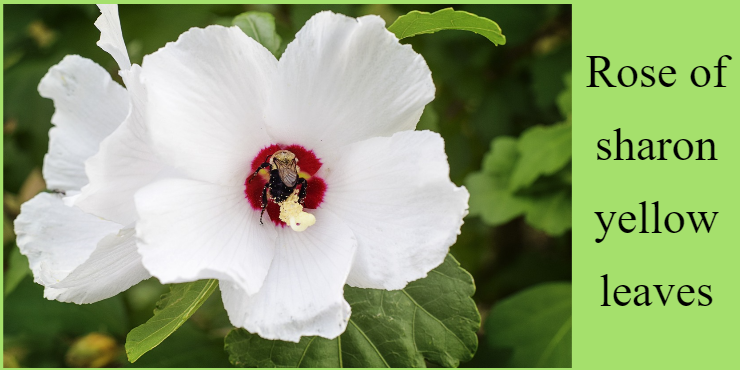Rose of Sharon yellow leaves is a hardy hibiscus plant that generally requires little maintenance is typically required. Nonetheless, a frequent concern among gardeners is that may encounter is When faced with the issue of leaves turning yellow, though it may raise concerns, it is essential to understand that it can have various causes, ranging from minor to more severe. In this article, we will explore the reasons behind the rose of Sharon yellow leaves and provide practical solutions to help you address this problem effectively.
Is Constant Concern Necessary for Rose of Sharon Yellow Leaves?
Occasional yellow leaves on your Rose of Sharon yellow leaves should not be a need for alarm. Similar to all other plants, every leaf possesses a lifespan, and when it reaches the end, it will naturally turn yellow, wither, and fall off. As long as your hibiscus plant is not losing an excessive number of leaves and appears otherwise healthy, there is no need to worry. Simply pluck off the occasional yellow leaf and continue taking care of your plant.
Lots of Yellow Leaves Mean Trouble
While a few yellows And a few yellow leaves are natural, an excess of yellowing foliage may suggest Roots in potential concerns, let’s delve into some prevalent reasons behind yellowing. leaves on Rose of Sharon and discuss appropriate remedies:
Establishing a Thriving Rose of Sharon Garden
When selecting a spot for When selecting a location for your Hibiscus, be mindful of its capacity for abundant Natural reseeding, so be prepared to move any extra shoots. that might appear. The Rose of Sharon shrub prospers in well-draining soil.
l that is both moist and well-draining, with the exception of overly soggy or excessively dry conditions. For optimal growth, plant this flower during either the spring or autumn seasons. Opt for a location that receives abundant sunlight, dig a hole twice the width of the pot, and gently position the plant within it so that the crown rests just at or slightly above the soil’s surface. Proceed to fill the hole and ensure thorough watering.
Hydration Guidelines for Rose of Sharon

Optimal Soil Conditions for Rose of Sharon yellow leaves involve maintaining consistent moisture levels in well-draining soil. These plants are not drought-tolerant and require regular watering, potentially twice daily in hot weather.
To foster robust root growth, it’s advisable to provide deep, weekly hydration during the summer months. Excessive shallow watering or overwatering may lead to bud drop and increased vulnerability to pests and diseases. Avoid leaving them in standing water to prevent potential root damage and root rot.
Nourishing Your Rose of Sharon
When initially establishing your plant, provide it with a dose of all-purpose fertilizer. This infusion of nutrients is essential to sustain your Rose of Sharon yellow leaves during its inaugural year. While filling the planting hole, ensure thorough mixing of the fertilizer with the soil, followed by generous watering.
As a yearly regimen, offer your Rose of Sharon a springtime feeding as its leaves begin to emerge. Opt for a balanced fertilizer, such as 10-10-10 or 10-20-10, and apply it sparingly. In the midst of summer, consider supplementary feeding with a low-nitrogen fertilizer. Adhere to the instructions on the package and follow up with thorough watering to prevent any potential nutrient burn.
Trimming Your Rose of Sharon yellow leaves
Pruning requirements for Rose of Sharon yellow leaves are minimal, and typically reserved for size, shape, and aesthetic maintenance. It’s best to conduct pruning in late winter or early spring, right before the onset of fresh growth.
This is crucial because buds and flowers exclusively develop on the newly emerging growth each year. Pruning serves as a catalyst for increased branching, translating to a profusion of blossoms. Consider eliminating the least robust stems and all branches, up to approximately half the shrub’s height, to encourage optimal growth.
Nurturing Rose of Sharon yellow leaves in Containers
The Rose of Sharon yellow leaves prove to be a favored choice for container gardening, offering the convenience of indoor winter shelter. When opting for a container, select a spacious one equipped with adequate drainage holes. Employ high-quality potting soil for the best results, and position the container in a sun-drenched location to ensure optimal sunlight exposure.
In warmer climates, be diligent about regular watering, potentially twice daily, given that container moisture tends to evaporate swiftly. Sustained blooming places high demands on nutrient levels, making it advisable to repot the plant annually, replenishing it with fresh soil for continued health and vibrancy.
Winter Maintenance for Rose of Sharon yellow leaves

In anticipation of winter, discontinue fertilization by the onset of July. This strategy prevents the initiation of fresh growth, allowing the plant to conserve energy for the colder months ahead. For most regions, minimal care is necessary during the winter season.
In colder locales, robust varieties may experience dieback to ground level, but come spring, new growth will emerge from the roots. To safeguard the roots in colder climates, consider applying mulch around the plant’s base to provide insulation. Surprisingly, certain hibiscus varieties actually benefit from exposure to freezing temperatures, as it stimulates new growth. Engaging in late winter pruning can also prove advantageous, setting the stage for vibrant spring regrowth.
Fungus
One potential cause of yellow leaves in those Sharon yellow leaves is root rot, which is often caused by a fungal infection. This problem typically arises when the shrub is planted in dense, waterlogged soil that restricts the roots’ access to oxygen. To prevent root rot, it is crucial to ensure that the soil is well-draining and moist.
If your Rose of Sharon is in a container, make sure it has proper drainage holes that are not blocked. Additionally, avoid overwatering and practice soak and dry watering, allowing the top few inches of soil to dry out before watering again. Other fungal diseases, such as leaf spots, blights, and cankers, can also lead to yellowing leaves.
Pests
Infestation by pests like whiteflies and aphids can also cause yellowing leaves on the Rose of Sharon yellow leaves. While this shrub is generally resistant to pests, overwatering can weaken the plant and make it more susceptible to infestations. If you notice unwelcome insects on your Rose of Sharon, blast them off with a strong spray of water from a garden hose.
Follow up with a treatment of horticultural oil, neem oil, or insecticidal soap to keep pests at bay. Regular preventative treatments can help protect your plant. For aphids, spraying soapy water on both sides of the leaves at dusk or dawn can also be effective. Applying an all-purpose fungicide to the entire plant can help combat other pests as well.
Excess Shade
Insufficient sunlight can lead to yellowing leaves on the Rose of Sharon yellow leaves. These deciduous plants require at least four hours of direct sunlight each day. If your shrub is not receiving adequate sunlight, consider providing afternoon shade or partial shade.
If the plant is in a container, monitor its location and ensure it is getting the right amount of sunlight. Keep an eye on surrounding trees as well, as they may shade the Rose of Sharon and block the sun. Prune any overgrown branches to allow sunlight to reach the plant.
Too Much Watering
Overwatering can cause not only yellow leaves but also brown spots on the Rose of Sharon yellow leaves. Excess moisture around the root ball can lead to these issues. To prevent overwatering, always check the soil moisture and ensure proper drainage. Once established, the Rose of Sharon becomes drought-tolerant and requires less frequent watering.
Chlorosis! How to Treat Yellowing Foliage
Chlorosis is a condition characterized by the yellowing of entire leaves due to a lack of essential nutrients such as nitrogen, potassium, magnesium, iron, zinc, or manganese. Rose of Sharon generally does not require excessive fertilization, and overdoing it can result in root damage. Provide adequate hibiscus plant food to support healthy foliage and beautiful flowers.
To address chlorosis, test the pH balance of your soil and amend it if necessary. High alkalinity can hinder nutrient absorption. Additionally, test the nutrient levels in your soil to ensure the plant’s nutritional needs are met. Remove weeds and turf from around the base of the shrub, and consider adding a mulch of cedar, pine, or hardwood chips to retain moisture and reduce alkalinity. Avoid letting the mulch touch the trunk, as it may cause damage. Lightly apply a balanced fertilizer (10-10-10) in early spring and mid-summer, ensuring proper watering before and after fertilizing.
Will Yellow Leaves Recover?
Once a leaf on your Rose of Sharon turns yellow, it is a sign that it is nearing the end of its lifespan. Yellow leaves will not recover, so it is best to prune them close to the stem using sterilized cutting tools. Removing yellow leaves is important as they drain the plant’s energy and provide hiding places for pests and disease-causing organisms. Remember to clean your pruning tools thoroughly to prevent the spread of any potential diseases.
Conclusion
Understanding the reasons behind yellow leaves on the Rose of Sharon is crucial for maintaining the health and vitality of your hibiscus plant. By addressing the underlying causes such as root rot, pests, shade, overwatering, and nutrient deficiencies, you can help prevent and treat yellowing foliage. Regular care, proper watering, and providing the right amount of sunlight will contribute to the overall well-being of your Rose of Sharon. Enjoy the beauty of this hardy shrub by keeping its leaves vibrant and green.
Additional Information: It is worth noting that yellowing leaves can also be a natural part of the plant’s seasonal cycle. As autumn approaches, some leaves may turn yellow and fall off. Differentiating between normal seasonal changes and underlying problems is essential for effective plant care.
The tone of Voice: The tone of this article is informative and authoritative, providing practical solutions and tips for dealing with yellow leaves on Rose of Sharon. The language used is professional yet accessible, ensuring that both experienced gardeners and beginners can benefit from the information provided.


